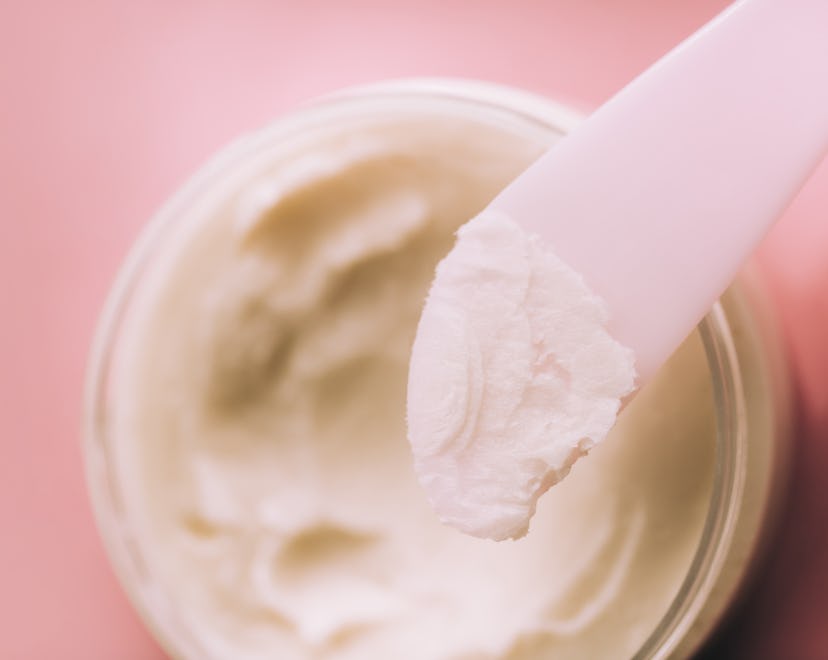Breastfeeding

Coconut Oil Is A Great Remedy For Nipple Pain
And it’s totally safe for baby, too.
Along with all of the wonderful feelings that come with breastfeeding, it’s not uncommon to encounter a few painful ones, too. To treat nursing discomfort, some moms swear by natural home remedies like using coconut oil for nipple pain. But is coconut oil safe to use while breastfeeding?
It seems like coconut oil is everywhere these days — it’s in your popcorn, in your shampoo, and more people are using it in their everyday cooking. It’s also been pretty widely promoted as a remedy to heal skin, so if you have sore or blistered nipples, you may be tempted to try it for yourself.
Why Lactation Consultants Recommend Using Coconut Oil
“Coconut oil is a great option because it is a natural antimicrobial and antibacterial. Cracked nipples can leave you prone to mastitis so those qualities are beneficial in a nipple ointment,” nurse and lactation consultant Tera Hamann tells Romper. “It’s also affordable and accessible, easy to find at any grocery store and can even be found in packets for easy use on the go.”
Not only is coconut oil beneficial for your skin and promoting healing, it’s also safe. The best part about using coconut oil on your nipples is that it’s safe for your baby, so you don’t have to wipe it off before feedings.
“It’s safe to use on the skin and is also safe for baby to nurse with remnants of coconut oil on the nipples,” Ashley Georgakopoulos, IBCLC and Motif Medical Lactation Director, tells Romper. “The skin absorbs the oil really well, and it’s sometimes easier to work with — and usually already handy — than thicker products on the market.”
IBCLC Kristin Gourley also tells Romper that coconut oil is helpful in healing wounds, and safe to use while nursing, which eliminates the need to continuously wash already sore nipples.
Gourley suggests that if you don’t have coconut oil on hand, olive oil also has similar properties and can soothe nipple pain, too. She adds that the moisturizing properties of both coconut and olive oil can promote healthy tissue in general, and they are way less sticky than lanolin, which is popularly used to treat nipples.
The Healing Properties Of Coconut Oil
The antibacterial and moisturizing properties of coconut oils have been studied comprehensively in recent years. Along with studies on health benefits from consuming coconut oil, there are extensive studies on its viability as a skin remedy, too. One study from the International Journal of Molecular Science found that coconut oil possesses anti-inflammatory properties and can help promote the healing of skin cells. Another study in the Natural Medicine Journal found that a key component of coconut oil is lauric acid, which has been proven to help kill a wide variety of bacteria on the skin.
“Coconut oil has both antimicrobial and antifungal properties,” Georgakopoulos says. “This speeds in healing processes because it helps avoid further problems like infections. The moisture component aids healing the nipples faster as well.”
Additionally, Georgakopoulos says there is an anti-yeast component to coconut oil, which she says “is important for damaged nipples to combat risk of thrush and other infections.” So, if you lather up at the first sign of pain, you increase your chances of staving off infections.
“Thrush almost never happens to healthy nipples, so cracked nipples, even microscopically/mild damage, pose a much greater risk — and this is where coconut oil comes in extremely handy,” she explains. “The first sign of soreness or creasing in the nipple, grab some coconut oil.”
Tips For Using Coconut Oil For Sore Nipples
Not all coconut oil is the same. If you’ve ever perused your local grocery store for coconut oils, I’m sure you have encountered numerous types, from liquids to solids, and varying in color. Because some healing properties in coconut oil can be lost as it is refined or purified, Healthline reported that raw, unrefined coconut oil is best for use on skin.
It’s worth noting that any oil, including coconut oil, will stain your clothes. “You do want to wear breast pads when you put oil on your nipples,” Gourley says, “so you don't get grease stains in your bra.” If your nipples are too sore for friction, you can always put on an old soft shirt that you don’t mind staining.
Hamann tells Romper that while coconut oil is totally safe for use on cracked nipples, it’s also important to get to the root cause of the pain. “The important thing to consider is that cracked nipples are the sign of a bad latch,” she says. “The best thing to do it to get hands-on help, preferably from an IBCLC. There are many things that can cause a bad latch and it’s best to get help.”
Hopefully, your nipple pain won’t last too long, but if it continues, reach out to a lactation consultant who will guide you on proper latching techniques and help get you back on track.
Studies Referenced:
Lin, T., Zhong, L., & Santiago, J. (2017, December 27). Anti-Inflammatory and skin Barrier Repair effects of topical application of some plant oils.
Elmore, L., Elmore, A., Elmore, L., Nance, G., Singleton, S., Lorenz, L. (n.d.). Treatment of dermal infections with topical coconut oil.
Experts:
Tera Hamann, BSN, RN, IBCLC
Kristin Gourley, IBCLC, IBCLC Manager at Lactation Link
Ashley Georgakopoulos, IBCLC and Motif Medical Lactation Director
This article was originally published on